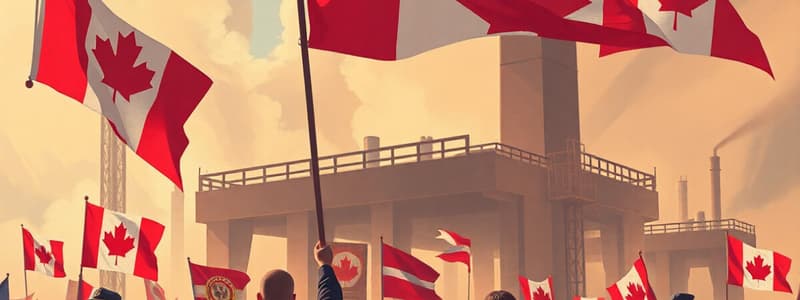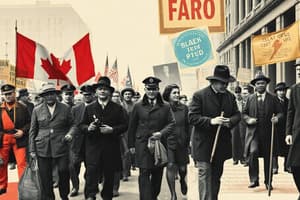Podcast
Questions and Answers
What was a significant barrier to the development of unions in Canada?
What was a significant barrier to the development of unions in Canada?
- Access to widespread industrial jobs
- Strong government support for unions
- High levels of union membership in Canada
- Tendency of unionists to join American-based internationals (correct)
What characterized the employment relationships in Canada before the First Industrial Revolution?
What characterized the employment relationships in Canada before the First Industrial Revolution?
- Paternalistic relationships often with relatives or friends (correct)
- Frequent strikes and organized labor activities
- Formal contracts between workers and employers
- Highly organized labor unions
What role did the government play in the growth of the Canadian labour movement during the 20th century?
What role did the government play in the growth of the Canadian labour movement during the 20th century?
- Taxed unions heavily to suppress their influence
- Promoted only public sector unions
- Discouraged union formation through restrictive laws
- Encouraged union growth through supportive legislation (correct)
Which factor was NOT mentioned as a problem facing the Canadian labour movement?
Which factor was NOT mentioned as a problem facing the Canadian labour movement?
What was the nature of the union activity prior to the First Industrial Revolution in Canada?
What was the nature of the union activity prior to the First Industrial Revolution in Canada?
What was a significant contributor to increased labor conflict in early Canada?
What was a significant contributor to increased labor conflict in early Canada?
Which characteristic describes the unions that existed before the First Industrial Revolution in Canada?
Which characteristic describes the unions that existed before the First Industrial Revolution in Canada?
Which of the following was NOT a response to the challenges faced by the Canadian labor movement?
Which of the following was NOT a response to the challenges faced by the Canadian labor movement?
What triggered the Canadian labour movement to initially attempt to elect members to Parliament?
What triggered the Canadian labour movement to initially attempt to elect members to Parliament?
What was the outcome of the Winnipeg General Strike of 1919?
What was the outcome of the Winnipeg General Strike of 1919?
What was a significant challenge faced by the Canadian labour movement in the 1920s?
What was a significant challenge faced by the Canadian labour movement in the 1920s?
What was the unemployment rate among Canadian workers by 1933 during the Great Depression?
What was the unemployment rate among Canadian workers by 1933 during the Great Depression?
What type of new approaches did Canadian workers begin to explore during the Great Depression?
What type of new approaches did Canadian workers begin to explore during the Great Depression?
Which party was launched during the Great Depression as a broad-based coalition?
Which party was launched during the Great Depression as a broad-based coalition?
How much did inmates in government-sponsored relief camps earn per day during the Great Depression?
How much did inmates in government-sponsored relief camps earn per day during the Great Depression?
What significant hope began to emerge for Canadian workers by 1935?
What significant hope began to emerge for Canadian workers by 1935?
What factor retarded the development of a strong labour movement in Quebec during the 19th century?
What factor retarded the development of a strong labour movement in Quebec during the 19th century?
What management style was introduced during Canada's first sizeable factories to control labour costs?
What management style was introduced during Canada's first sizeable factories to control labour costs?
What was one of the key events during the First Industrial Revolution in Canada?
What was one of the key events during the First Industrial Revolution in Canada?
What was a significant social challenge posed by the Knights of Labor during their time in Canada?
What was a significant social challenge posed by the Knights of Labor during their time in Canada?
Which act did the federal government pass in recognition of working people's political power?
Which act did the federal government pass in recognition of working people's political power?
What motivated many Quebec workers to seek jobs in the U.S. rather than in English Canada?
What motivated many Quebec workers to seek jobs in the U.S. rather than in English Canada?
What type of unions began forming in Canada as a response to harsher working conditions in factories?
What type of unions began forming in Canada as a response to harsher working conditions in factories?
What was the status of unions under the Quebec government during the 19th century?
What was the status of unions under the Quebec government during the 19th century?
What significant merger occurred in 1956 in the Canadian labor movement?
What significant merger occurred in 1956 in the Canadian labor movement?
What marked the end of the major Communist influence within the Canadian labor movement?
What marked the end of the major Communist influence within the Canadian labor movement?
Which group joined the labor movement in large numbers for the first time during the 1960s?
Which group joined the labor movement in large numbers for the first time during the 1960s?
What was a primary characteristic of strikes in the post-World War II era?
What was a primary characteristic of strikes in the post-World War II era?
What was a notable event for labor militancy in Quebec during the 1970s?
What was a notable event for labor militancy in Quebec during the 1970s?
How did younger workers in the labor force during the 1960s express their discontent?
How did younger workers in the labor force during the 1960s express their discontent?
What was one of the outcomes of the expansion of public sector unionization in the 1960s?
What was one of the outcomes of the expansion of public sector unionization in the 1960s?
What effect did the decreased membership in unions during the early 1960s have on the labor movement?
What effect did the decreased membership in unions during the early 1960s have on the labor movement?
What was a major focus of Brian Mulroney's Conservative government post-1984?
What was a major focus of Brian Mulroney's Conservative government post-1984?
Which union broke away from the Canadian Labour Congress in 1985?
Which union broke away from the Canadian Labour Congress in 1985?
What was a significant internal issue faced by the Canadian labour movement during the 1980s?
What was a significant internal issue faced by the Canadian labour movement during the 1980s?
What principle did the Canadian Federation of Labour operate under?
What principle did the Canadian Federation of Labour operate under?
What major economic development in the 1990s impacted the Canadian labour movement?
What major economic development in the 1990s impacted the Canadian labour movement?
What led to the rise of union raiding during the 1980s?
What led to the rise of union raiding during the 1980s?
Which of the following was NOT part of Mulroney's government agenda?
Which of the following was NOT part of Mulroney's government agenda?
What was one of the consequences of the schisms and breakaways in the Canadian labour movement?
What was one of the consequences of the schisms and breakaways in the Canadian labour movement?
What was one of the primary pressures placed on employers due to trade agreements?
What was one of the primary pressures placed on employers due to trade agreements?
What type of work arrangements grew as a consequence of economic changes during this period?
What type of work arrangements grew as a consequence of economic changes during this period?
What significant action did public sector workers take in response to their working conditions?
What significant action did public sector workers take in response to their working conditions?
Which political party faced backlash from the labour movement for its previous actions in government?
Which political party faced backlash from the labour movement for its previous actions in government?
What was a common feature that diminished in labour management relations as economic conditions changed?
What was a common feature that diminished in labour management relations as economic conditions changed?
What impact did the formation of broader regional trading blocs have on Canada?
What impact did the formation of broader regional trading blocs have on Canada?
During the period from 1985 to 2000, how did employers react despite economic recovery?
During the period from 1985 to 2000, how did employers react despite economic recovery?
What labor movement strategy was employed in response to the changing economic landscape?
What labor movement strategy was employed in response to the changing economic landscape?
Flashcards
Pre-Industrial Period in Canada
Pre-Industrial Period in Canada
The period before the Industrial Revolution in Canada where most people were self-employed or worked in small, local, family-based businesses. There was limited union activity and harsh laws against unions.
Anti-conspiracy legislation
Anti-conspiracy legislation
Laws that were used to restrict union activity during the Pre-Industrial Period in Canada. These laws made it difficult for workers to come together and organize for improved working conditions.
Friendly Societies
Friendly Societies
Groups that were formed to provide mutual support and insurance to members, sometimes masquerading as unions in the Pre-Industrial Period in Canada.
Immigration and Labor Conflict
Immigration and Labor Conflict
Signup and view all the flashcards
First Industrial Revolution in Canada
First Industrial Revolution in Canada
Signup and view all the flashcards
Fragmentation of the Canadian Labour Movement
Fragmentation of the Canadian Labour Movement
Signup and view all the flashcards
Joining American-based International Unions
Joining American-based International Unions
Signup and view all the flashcards
Government Role in Encouraging Union Growth
Government Role in Encouraging Union Growth
Signup and view all the flashcards
Early Labor Organization in Canada
Early Labor Organization in Canada
Signup and view all the flashcards
Early Union Restrictions in Canada
Early Union Restrictions in Canada
Signup and view all the flashcards
Government Suppression of Protests in Quebec
Government Suppression of Protests in Quebec
Signup and view all the flashcards
Limited Influence of Craft Organizations in Quebec
Limited Influence of Craft Organizations in Quebec
Signup and view all the flashcards
Quebec Workers Seeking Opportunities in the U.S.
Quebec Workers Seeking Opportunities in the U.S.
Signup and view all the flashcards
Emergence of Factories in Canada
Emergence of Factories in Canada
Signup and view all the flashcards
Coercive Drive Management
Coercive Drive Management
Signup and view all the flashcards
Formation of Craft Unions in Canada
Formation of Craft Unions in Canada
Signup and view all the flashcards
Early 20th Century Labour Movement
Early 20th Century Labour Movement
Signup and view all the flashcards
Labour Movement in the 1920s
Labour Movement in the 1920s
Signup and view all the flashcards
Impact of the Great Depression on Labour
Impact of the Great Depression on Labour
Signup and view all the flashcards
Labour Resilience During the Great Depression
Labour Resilience During the Great Depression
Signup and view all the flashcards
Workers' Unity League in Ontario
Workers' Unity League in Ontario
Signup and view all the flashcards
Formation of the CCF
Formation of the CCF
Signup and view all the flashcards
Union membership decline in the 1960s
Union membership decline in the 1960s
Signup and view all the flashcards
TLC and CCL Merger (1956)
TLC and CCL Merger (1956)
Signup and view all the flashcards
Public Sector Unionization in the 1960s
Public Sector Unionization in the 1960s
Signup and view all the flashcards
Shifting Bargaining Agendas in the 1960s
Shifting Bargaining Agendas in the 1960s
Signup and view all the flashcards
Renewed Labor Militancy in the 1960s
Renewed Labor Militancy in the 1960s
Signup and view all the flashcards
Young Workers' Influence on Labor
Young Workers' Influence on Labor
Signup and view all the flashcards
Uneven Prosperity in the 1960s
Uneven Prosperity in the 1960s
Signup and view all the flashcards
Declining Communist Influence
Declining Communist Influence
Signup and view all the flashcards
Mulroney's Conservative Agenda
Mulroney's Conservative Agenda
Signup and view all the flashcards
Internal Challenges of the 1980s
Internal Challenges of the 1980s
Signup and view all the flashcards
The Birth of the CFL
The Birth of the CFL
Signup and view all the flashcards
The CAW Breakaway
The CAW Breakaway
Signup and view all the flashcards
Union Raiding: A Source of Conflict
Union Raiding: A Source of Conflict
Signup and view all the flashcards
NAFTA's Impact on Labor
NAFTA's Impact on Labor
Signup and view all the flashcards
Flexible Labor Markets
Flexible Labor Markets
Signup and view all the flashcards
Globalization and Labor
Globalization and Labor
Signup and view all the flashcards
What is 'sea change' in this context?
What is 'sea change' in this context?
Signup and view all the flashcards
What changed in the employer-worker relationship?
What changed in the employer-worker relationship?
Signup and view all the flashcards
How did globalized trade affect Canada?
How did globalized trade affect Canada?
Signup and view all the flashcards
How did trade agreements influence work arrangements?
How did trade agreements influence work arrangements?
Signup and view all the flashcards
What happened to public sector workers?
What happened to public sector workers?
Signup and view all the flashcards
How did the labor movement respond to these changes?
How did the labor movement respond to these changes?
Signup and view all the flashcards
How did the 'social contract' affect the NDP?
How did the 'social contract' affect the NDP?
Signup and view all the flashcards
How did the labor movement's political ties change?
How did the labor movement's political ties change?
Signup and view all the flashcards
Study Notes
Chapter 2: The History of the Canadian Labour Movement
- The chapter traces the development of the Canadian labour movement from craft to industrial to public sector unionism.
- It examines the role of government, Canadian unions' political involvement, and international unions.
Development of Canadian Unions: A Brief Overview
-
The Canadian labour movement evolved from a small, locally based movement in the 19th century.
-
Key obstacles unique to Canada included:
- Late industrialization
- Sparse population
- Significant foreign (often US) control over the Canadian economy
- Division between English and French movements
-
Canadian unionists often joined US-based international unions rather than Canadian unions.
-
Government legislation played a crucial role in fostering union growth.
Pre-Industrial Period
- Organized labour activity, like strikes, existed as early as the 18th century, but was rare before 1850.
- Most Canadians were self-employed or worked for family/friends in a paternalistic way.
Early Labour Organization in Quebec
- The Quebec government, like other Canadian governments, banned unions.
- Worker protests were often seen as seditious, and craft unions were suppressed by the Catholic Church.
- Discrimination against Quebec workers in US canals and railways further hindered union development.
Labour in the First Industrial Revolution
- Large factories, mines, railways, and lumber mills emerged in the mid-19th century, employing hundreds.
- Employers sought to control labour costs and maximise profits, which led to harsh working conditions.
- Workers responded with the formation of craft unions, often affiliated with American international unions.
Labour in the Second Industrial Revolution
- Industrial revolution of the late 19th century saw factories become larger and more capital intensive.
- AFL president, Samuel Gompers, heavily involved in organizing Canadian workers.
- The Trades and Labour Congress (TLC) played a key role in the development of the Canadian labour movement.
- International unions like the IWW had a significant impact on Canadian labour movements.
The First World War and its Aftermath
- Labour shortages and rising prices during World War I led to rapid union growth.
- The Winnipeg General Strike of 1919, a significant event
- Socialism and radical protest were integral to the movement
Labour During the Depression
- The Great Depression (1930s) severely impacted workers, leading to high unemployment and poverty.
- Workers utilized new approaches to address their issues, including a variety of political involvement
Labour During WWII
- Prime Minister Mackenzie King's policies regarding Canadian workers led to labour strife.
- Canada Labour Relations Board was created in 1944 to establish union, bargaining, and striking rights.
Labour During the 1950s
- The 1950s saw union consolidation and stabilization, focusing on improved wages and work conditions.
- End of Communist influence in the labour movement.
Labour During the 1960s
- Public sector unionization became a major factor, with women and professional/white-collar workers entering the workforce.
- Renewed labour militancy, particularly in Quebec.
Labour in the 1970s & 1980s
- The 1970s and 80s were marked by significant challenges like recession, political change, and declining trade union membership.
Labour in the 1990s
- NAFTA and global economic integration presented significant challenges to Canadian labour in the 1990s.
- Labour activists and unions addressed difficult employment conditions and worker rights.
Canadian Labour at the Dawn of the New Millennium
- The study notes end by assessing the lasting impact of global economic integration, and the evolving role of labour unions.
- Issues of workplace relations and workers' rights are identified as continuing priorities for labour movements and unions.
Studying That Suits You
Use AI to generate personalized quizzes and flashcards to suit your learning preferences.




